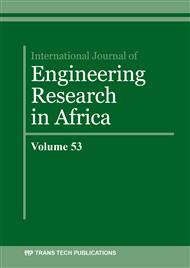[1]
A. Dalelo, Rural Electrification in Ethiopia: Opportunities and Bottlenecks. Addis Ababa University, Addis Ababa (2019) 180.
DOI: 10.33564/ijeast.2022.v07i03.005
Google Scholar
[2]
Energy Situation in Ethiopia, energypedia, 2017. [Online]. Available: https://energypedia.info/wiki/Ethiopia_Energy_Situation.
Google Scholar
[3]
A. Tesfa, Feasibility Study of Off-grid Hybrid Systems: Mini- Hydro, PV and Wind for Rural Electrifcation in Ethiopia, Addis Abeba: Addis Abeba University, (2015) 138.
DOI: 10.15415/jmrh.2015.21005
Google Scholar
[4]
Ethiopia's Transformational Approach to Universal Electrification. World Bank Group, 8 March 2018. [Online]. Available: https://www.worldbank.org/en/news/feature/2018/03/08/ethiopias-transformational-approach-to-universal-electrification.
Google Scholar
[5]
F. Rizzo, Electricity Supply to Africa and Developing Economies–Challenges and Opportunities, in: 8th Southern African Regional Conference, (2017).
Google Scholar
[6]
Feasibility Study on Mega Solar, Hybrid Mini Grid and Rural Electrification for Communities by Solar PV System in Federal Democratic Republic of Ethiopia and Republic of Kenya. Ministry of Economy, Trade and Industry, (2015).
Google Scholar
[7]
M. Jacobson, C. Draxl, T. Jimenez, B. O'Neill, Assessing the Wind Energy Potential in Bangladesh, National Renewable energy Labortory, (2018).
Google Scholar
[8]
Z.A. Alemu, A.A. Ahmed, A.W. Yalew et al., Spatial Variations of Household Food Insecurity in East Gojjam Zone, Amhara Region, Ethiopia: Implications for Agroecosystem-Based Interventions, Agric and Food Security, 6, (2017), 36.
DOI: 10.1186/s40066-017-0113-9
Google Scholar
[9]
G.D. Nage, Estimation of Monthly Average Daily Solar Radiation from Meteorological Parameters: Sunshine Hours and Measured Temperature in Tepi, Ethiopia, International Journal of Energy and Environmental Science, 3(1) (2018), 19-26.
DOI: 10.11648/j.ijees.20180301.12
Google Scholar
[10]
F. Drake, Y. Mulugeta, Assessment of Solar and Wind Energy Resources in Ethiopia, Solar Energy, 57(3) (2017), 1996-2004.
DOI: 10.1016/s0038-092x(96)00074-6
Google Scholar
[11]
N. Argaw, Estimation of Solar Radiation Energy of Ethiopia from Sunshine Data, International Journal of Solar Energy, 18(2) (2016) 103-113.
DOI: 10.1080/01425919608914309
Google Scholar
[12]
G. Bekele, G. Boneya, Design of a Photovoltaic-Wind Hybrid Power Generation System for Ethiopian Remote Area, Energy procedia, 14 (2012) 1760-1765.
DOI: 10.1016/j.egypro.2011.12.1164
Google Scholar
[13]
G. Bekele, G. Tadesse, Feasibility study of small Hydro/PV/Wind hybrid system for off-grid rural electrification in Ethiopia, Applied Energy, 97 (2012) 5-15.
DOI: 10.1016/j.apenergy.2011.11.059
Google Scholar
[14]
T. Bayou, A. Assefa, Solar Radiation Maps for Ethiopia, Journal of EAEA, 8, (1989) 7-16.
Google Scholar
[15]
H. Ibrahim, Estimation of Global Solar Radiation Using Sunshine-based and and Temperature Based models: case study of Adama Town, Haramaya, M.Sc. Thesis, Haramaya University, (2015) 115.
Google Scholar
[16]
G. Tadesse, G. Bekele, Feasibility study of small Hydro/PV/Wind hybrid system for off-grid rural electrification in Ethiopia, Applied Energy, (2012) 5-15.
DOI: 10.1016/j.apenergy.2011.11.059
Google Scholar
[17]
K. Namrata, S. Saksena, S.P. Sharma, Estimation of Global and Diffuse Solar Radiation for Jamshedpur, Jharkhand, India, International Journal of Science and Advanced Technology, 2(1) (2012) 44-47.
Google Scholar
[18]
H.O. Nnabuenyi, L.N. Okoli, F.C. Nwosu, G. Ibe, Estimation of Global Solar Radiation Using Sunshine and Temperature Based Models for Oko Town in Anambra State, Nigeria, American Journal of Renewable and Sustainable Energy, 3(2) (2017) 8-14.
Google Scholar
[19]
R.C.S.H. Pandey, Estimating Angstrom-Prescott Coefficients for India and Developing a Correlation between Sunshine Hours and Global Solar Radiation for India, International Scholarly Research Notices, (2013) 1-7.
DOI: 10.1155/2013/403742
Google Scholar
[20]
M.N.I. Sarkar, Estimation of solar radiation from cloud cover data, Renewables: Wind, Water and Solar, 3(11) (2016) 1-15.
DOI: 10.1186/s40807-016-0031-7
Google Scholar
[21]
S. Tessema, G. Bekele, Resource assessment and optimization study of efficient type hybrid power system for electrification of Rural District in Ethiopia, International Journal of Energy and Power Engineering, 3(6) (2014) 331-340.
DOI: 10.11648/j.ijepe.20140306.16
Google Scholar


